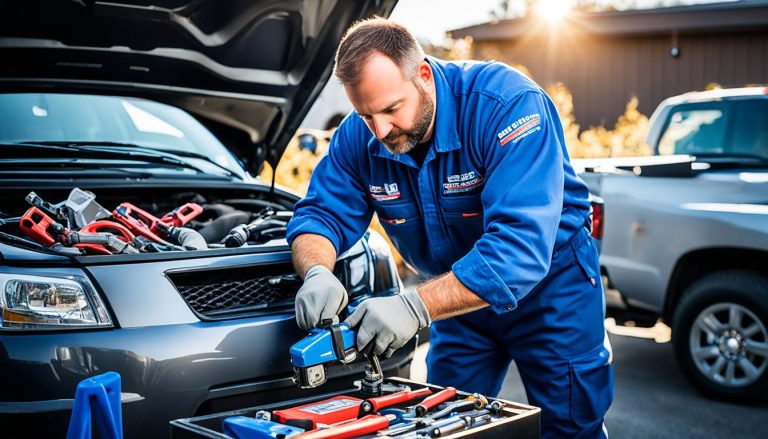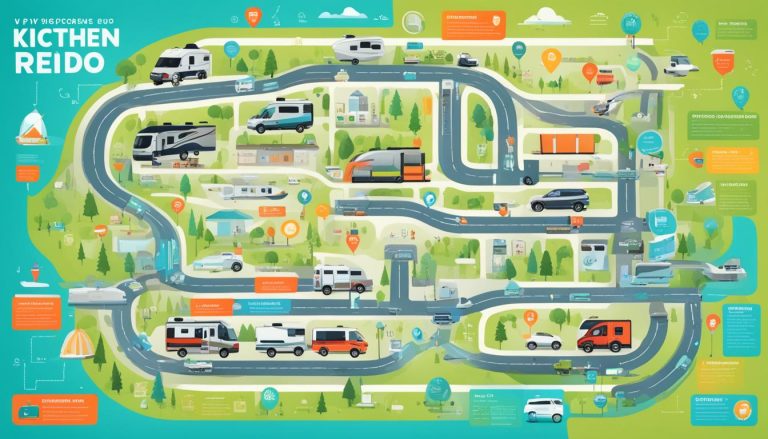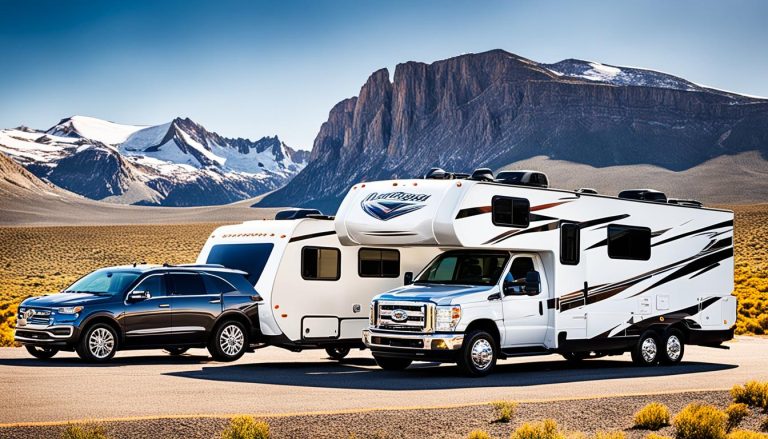Eco Analysis: Environmental Impact of Towable RV
gorvlifestyle.com and its partners may earn a commission if you purchase a product through one of our links
The zeal for open roads and the allure of nature have long drawn adventurers towards the RV lifestyle. In recent times, this passion for travel has been tempered with a growing concern for the environment, leading to a pivotal shift in the recreational vehicle (RV) industry. Notably, the environmental impact of towable RVs has come under scrutiny as the collective consciousness of eco-friendly RV camping, green RVing, and sustainable RV travel burgeons. Amidst this backdrop, key industry frontrunners, like Thor Industries and Winnebago Industries, are steering the charge by integrating sustainable amenities that foster environmental conservation in RVing. This revolutionary wave of eco-consciousness is reshaping the RV marketplace, further solidifying the movement towards a more responsible, low-impact approach to the beloved tradition of RVing.
As more enthusiasts opt for the caravan lifestyle, it becomes imperative to assess the RV carbon footprint and evaluate how sustainable practices can be infused into every mile traveled. With technological innovations paving the way, the future of RV travel is being reimagined to harmonize adventure with environmental fidelity, ensuring that the natural landscapes treasured by RVers today remain unspoiled for future generations to roam and relish.
Key Takeaways
- Technological advancements in the RV industry are increasingly focused on minimizing the environmental impact of towable RVs.
- Well-known brands like Thor Industries and Winnebago Industries are key players in promoting eco-friendly RV camping through the adoption of green innovations.
- The rise of green RVing reflects a deeper societal trend towards sustainable RV travel and environmental awareness.
- Evaluating the RV carbon footprint is crucial for fostering environmental conservation within the RVing community.
- Through conscientious practices, the RV industry is evolving to offer travel experiences that are both enriching and environmentally considerate.
Introduction: The Growing Popularity of Towable RVs
The leisure RV travel industry in North America is witnessing a remarkable surge with Towable RVs at the forefront of this expansion. The Towable RVs market growth is not just a trend but a reflection of the evolving preferences among travelers seeking experiential journeys and flexible accommodations. The integration of vehicles in outdoor escapades and the increasing propensity for off-the-grid experiences have solidified the position of Towable RVs as the go-to option for adventurers.
Underpinning this growth is a notable shift towards sustainable RV practices and a sensitivity to the impact of RVing on the environment. Consumers are now more informed and concerned about their ecological footprint — a consciousness that manufacturers and industry stakeholders are keen to address. As such, eco-friendly RVs equipped with green technologies and built through environmentally considerate practices are steadily gaining market share and consumer approval.
| Feature | Sustainable RVs | Traditional RVs |
|---|---|---|
| Materials | Recycled or renewable | Conventional materials |
| Energy Efficiency | High with solar options | Varies, generally lower |
| Waste Management | Integrated solutions | Standard disposal systems |
| Market Demand | Rising significantly | Stable but shifting |
Industry trends further emphasize the burgeoning interest in sustainable RV practices, with developments in renewable energy resources, waste reduction systems, and advanced material use. These innovations cater directly to a demographic that prioritizes sustainability as part of their travel lifestyle. Echoing a broader movement for sustainable travel, the Towable RVs market is not only flourishing; it’s evolving — aligning with environmental imperatives and leisure activities alike.
Assessing the Environmental Footprint of Towable RV Manufacturing
Understanding the complexities of RV manufacturing impact on the environment begins with the materials and processes used in their construction. Industries committed to eco-conscious RV manufacturing are exploring innovative approaches to reduce the ecological footprint through every stage of production.
Materials and Energy Use in RV Construction
Towable RV manufacturing can no longer turn a blind eye to supply chain emissions and the overall resource consumption of the production process. By scrutinizing the types of materials and the energy used to construct RVs, manufacturers are spearheading green RVing initiatives that target reductions in waste and inefficiency. These strategies include utilizing recycled materials and designing RVs for greater energy efficiency.
Supply Chain and Emissions of RV Components
The ripple effects of RV manufacturing extend into the broader supply chain where supply chain emissions come into focus. Manufacturers are realizing the importance of sourcing components from suppliers who share a commitment to sustainability. By enforcing stricter emissions standards and adopting environmentally responsible production techniques, the RV manufacturing sector is making strides towards a greener future.
In these quest for sustainability, the towable RV industry faces its share of challenges. Yet, it is clear that the environmental footprint of these leisure vehicles is no longer an afterthought. With each progressive step, the industry moves closer to delivering eco-friendly solutions that support the world’s burgeoning eco-conscious community.
The On-Road Carbon Emissions of Towable RVs
As global awareness of environmental challenges increases, the towable RV industry is closely examining the carbon footprint of RVs. Manufacturers are responding to consumer demands for eco-friendly camping options by producing RVs that minimize emissions without sacrificing the freedom and flexibility that have made RV travel so popular.
Travel enthusiasts are becoming more environmentally conscious, integrating sustainable travel practices into their itineraries. Consequently, there is detailed attention towards the impact of RVs on air quality and climate change. The operational phase of RVs, particularly when they are on the road, contributes significantly to their overall environmental footprint.
Considering these elements, reducing Towable RV emissions is not just a technical challenge but a commitment to eco-conscious recreation. This shift is palpable in the ways RVers choose their vehicles and the manner in which they travel, reflecting a collective effort to tread more lightly upon the earth.
| Eco-Friendly Feature | Benefit | Consumer Impact |
|---|---|---|
| Improved Aerodynamic Design | Reduces drag, lowering fuel consumption | Travelers can cover more distance with less environmental impact |
| Lightweight Construction Materials | Decreases overall weight and emissions during travel | Enables use of smaller, more fuel-efficient tow vehicles |
| Energy Efficient Appliances | Reduces power usage and generator run-time | Lowers the RV’s demand on fossil fuels, aligning with sustainable living values |
| Integration of Solar Panels | Provides renewable energy to power RV systems | Supports off-grid camping, reducing reliance on hookups and minimizing carbon footprint |
It’s not just a shift in product design; it’s a shift in mindset. Campers are more attentive to the eco-friendly camping products they choose and are willing to invest in features that promise a greener lifestyle. This is evident in the popularity of sustainable campsite choices and an adherence to Leave No Trace principles.
Ultimately, the path to sustainable RV travel is a collaborative journey between manufacturers who innovate and campers who choose responsibly. As the industry continues to evolve, the hope is that towable RV emissions will become less of a concern, making way for generations of responsible and environmentally-conscious travelers.
Understanding the RV Carbon Footprint During Use
The quintessential road trip in an RV is a cherished American pastime, but it’s essential to recognize that the RV carbon footprint doesn’t end after the purchase. Indeed, the environmental impact of the RV lifestyle pervades its usage phase, urging enthusiasts to embrace sustainable RV usage. As road wanderers, incorporating green RV practices into our routines can significantly lessen our ecological imprints while still enabling us to savor the world’s beauty.
Sustaining the health of our planet while enjoying its splendors asks for a thorough understanding of practices that minimize energy consumption and emphasize emission reduction. RVers are, therefore, adopting innovative ways to mitigate environmental impacts—both big and small—during their travels.
- The installation of solar panels to harness the sun’s power for electricity needs.
- Upgrading to LED lighting to decrease energy use.
- Utilizing eco-friendly, biodegradable cleaning products.
- Investing in better insulation to enhance energy efficiency.
- Adhering to a “zero waste” mentality by reducing, reusing, and recycling resources.
It’s not just a journey; it’s a conscious effort to tread lightly on the earth, even as we explore it.
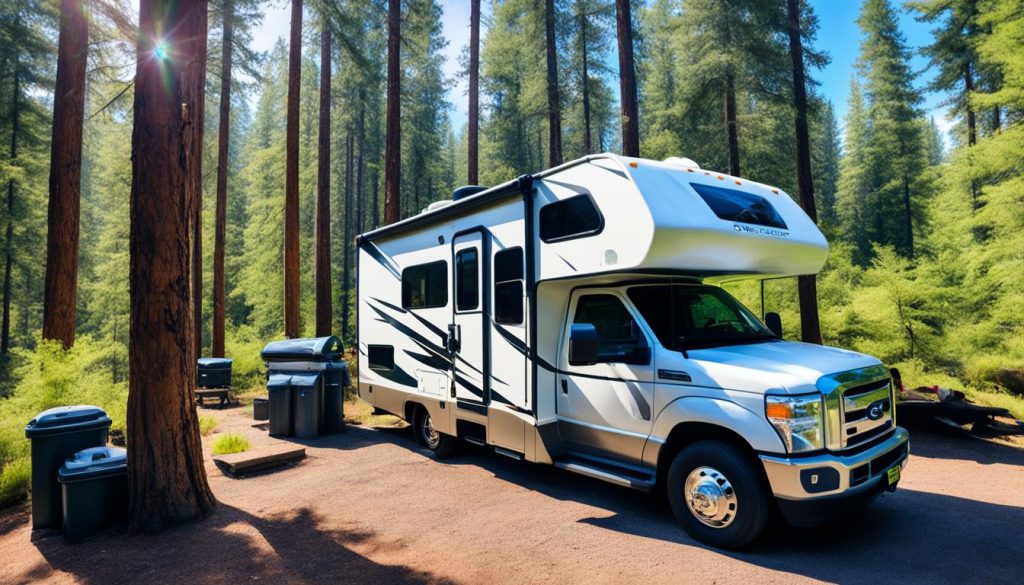
A practical way to visualize the impact of these efforts is by referring to a table that contrasts common practices against their more sustainable alternatives:
| Traditional Practice | Sustainable Alternative | Benefit |
|---|---|---|
| Conventional Generators | Solar/Wind Energy Systems | Renewable energy usage, noise and pollution reduction |
| Incandescent Bulbs | LED Lighting Solutions | Energy savings and longer lifespan |
| Chemical-laden Products | Eco-friendly Cleaning Supplies | Lower toxicity and biodegradability |
| Poor Insulation | Green Insulation Options | Improved energy conservation |
| Disposable Goods | Durable, Reusable Items | Waste reduction and cost efficiency |
As we immerse ourselves in the wanderlust of RV travel, it becomes clear that every choice we make can leave a lasting impact. By being mindful of our carbon footprint during RV use and integrating responsible habits, we set the wheels in motion towards a healthier environment. This journey toward sustainable RV usage will not only ensure that our cherished outdoor spaces endure but will also forge a path of stewardship for generations of adventurers to come.
Comparative Analysis of Eco-Friendly and Traditional RV Models
As the caravan industry pivots towards environmentally responsible RVing, discerning consumers are increasingly looking to understand the disparities between eco-friendly RV models and their traditional counterparts. Not only is there a palpable shift in consumer sentiment, but legislative pressures are also catalyzing the development of low-emission RV travel options, driving manufacturers toward innovation.
The contrast between the two RV models is stark when it comes to their environmental footprint. Traditional RVs have long been critiqued for their substantial carbon emissions and fuel inefficiency. However, the advent of eco-friendly RV models promises a different trajectory—a future where the romance of the open road and the ethos of conservation coalesce.
| Eco-Friendly RV Models | Traditional RV Impact |
|---|---|
| Advanced fuel efficiency | Higher fuel consumption |
| Use of renewable materials | Conventional construction materials |
| Solar power integration | Dependence on grid power |
| Lower CO2 emissions during travel | Higher emission levels |
| Recyclable and biodegradable components | Non-recyclable waste generation |
This transition to eco-friendly RV models responds not only to environmental imperatives but also to market demands for more sustainable lifestyle choices. The allure lies in harmonizing the freedom of RV-ing with a commitment to preserve the wild terrains and open spaces that RV-ers hold dear. By choosing low-emission travel alternatives, enthusiasts can indulge in their wanderlust without leaving an indelible mark upon the environment they explore.
- Better air quality due to reduced emissions
- Incentivization of sustainable practices in the RV industry
- Increased long-term savings with energy-efficient features
- Enhancement of RV resale values as demand for green technology grows
In this detailed comparative analysis, the overarching narrative is clear: low-emission RV travel embodies not only a more responsible approach to RVing but also a smarter investment into the future of travel and environmental conservation. As eco-friendly RV models continue to evolve, so too does the promise of a greener horizon for adventurers and the natural world alike.
Environmental Impact of Towable RV
With the travel culture shifting towards a more eco-conscious RV lifestyle, the environmental impact of towable RVs is being scrutinized more than ever. Acknowledging the critical role of preservation, key industry players are rethinking designs with an emphasis on sustainable materials in RVs. This reflects a larger trend towards low-impact RV vacations that cater to environmentally aware adventurers.
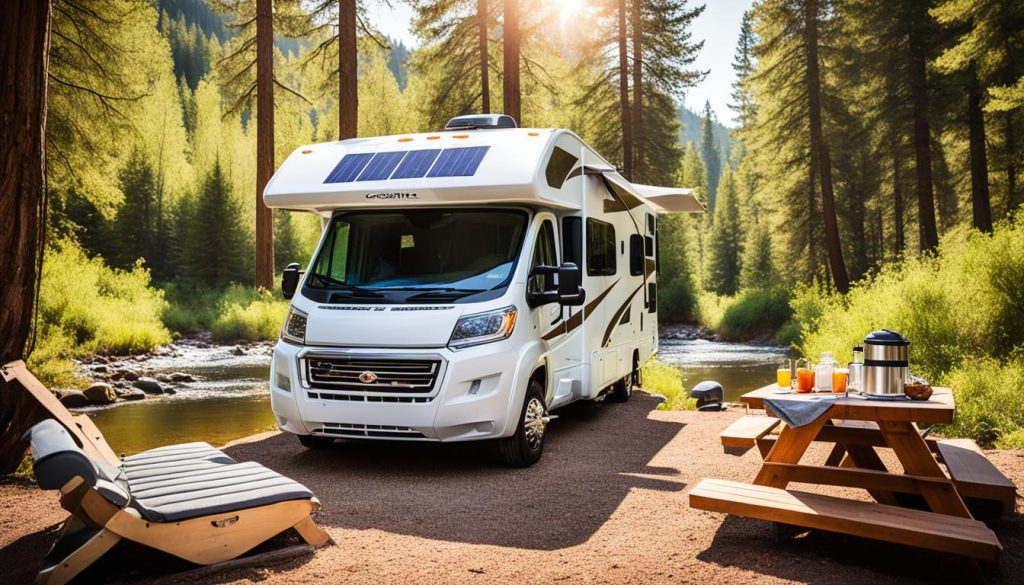
As travelers become increasingly aware of their carbon footprint, the pursuit of an environmentally friendly escape is no longer a niche but a norm. Towable RVs, when built and utilized responsibly, can be part of the solution for sustainable travel. Manufacturers who invest in sustainable materials and incorporate energy-efficient technologies are at the forefront of an ecological transition within the industry. Moreover, RV enthusiasts are adopting practices that contribute to less intrusive and cleaner vacation experiences.
“The call for a greener getaway has never been louder, as outdoor enthusiasts seek harmony with nature, not only in spirit but in practice.”
Encouraging the adoption of an eco-conscious RV lifestyle involves educating on the benefits of sustainable materials and eco-friendly amenities. Let us examine some of the choices and practices that reflect this commendable shift:
- Use of recycled or renewable materials in RV construction
- Integration of solar panels and energy-efficient appliances
- Promotion of best practices for fuel efficiency during travel
- Support of campgrounds that emphasize conservation and recycling
In the below table, we contrast traditional RV materials with sustainable alternatives to illustrate the beneficial shift towards greener living on wheels:
| Traditional Materials | Sustainable Alternatives |
|---|---|
| Standard Insulation | Recycled Cotton or Wool-based Insulation |
| Wood Composite Paneling | FSC-Certified or Reclaimed Wood Paneling |
| Synthetic Countertops | Recycled Glass or Composite Countertops |
| Conventional Rubber Roofing | Eco-Friendly TPO or EPDM Roofing |
These pragmatic yet profound shifts in material choices and practices not only reduce the environmental impact but also pave the way for a richer connection with the planet during our travel experiences, ultimately enabling us to enjoy our natural world responsibly for generations to come.
Sustainable RV Travel: Incorporating Green Practices
The essence of sustainable RV travel is deeply rooted in the core values of environmental stewardship, inspiring RV enthusiasts to adopt practices that reduce their ecological footprint. It’s not just about traversing the scenic routes; it’s about doing so responsibly. By focusing on strategies to reduce RV waste and conserve resources, alongside integrating green RVing products, road travelers can significantly contribute to a healthier planet.
Reducing Waste and Conserving Resources While RVing
Embarking on an RV journey no longer means leaving sustainability at home. Conservation of resources while RVing is achieved through mindful practices, such as:
- Minimizing water usage with low-flow faucets and showerheads
- Opting for reusable containers and products to cut down on disposable waste
- Investing in long-lasting LED lighting to lower energy consumption
These simple yet effective habits ensure that the beauty of the natural landscapes remains unmarred by the excesses of human activity.
Eco-Friendly Product Innovations for RV Owners
Innovation in RV-related products has opened up a new realm of possibilities for green RVing. Forward-thinking companies have recognized the demand for sustainable solutions, leading to a surge in products that support an eco-friendly RV lifestyle.
| Eco-Friendly Product | Benefits | Additional Features |
|---|---|---|
| Solar Panel Kits | Reduction in generator use, Harnessing renewable energy | Portable, Easy installation |
| Biodegradable Cleaning Supplies | Non-toxic, Safe for the environment | Plant-based ingredients |
| Composting Toilets | Reduces water usage, Lowers waste production | Odorless, Compact design |
| Reusable Water Bottles with Filters | Eliminates single-use plastics, Ensures clean drinking water | Durable, Variety of filtration systems |
These green RVing products not only diminish the environmental impact but also offer cost savings and increased self-sufficiency on the road. The synergy between reducing waste and embracing these eco-friendly innovations characterizes the modern sustainable RV travel lifestyle. Enthusiasts are now better equipped than ever to leave a lighter footprint as they explore the vastness of the open road.
Preserving Natural Habitats with Low-Impact RV Vacations
The rise of low-impact RV vacations marks a pivotal moment for both the travel community and the environment. These intentional getaways are not just a nod to responsible RV travel, but they also showcase the efforts made in the eco-tourism RV industry to maintain the delicate balance between exploring and preserving natural habitats. Enthusiasts are turning to practices that reduce their ecological footprint, ensuring the beauty of the outdoors remains unspoiled for future generations.
As the demand for low-impact travel options grows, the RV industry is responding with innovative solutions and strategies. This form of travel doesn’t mean forsaking comfort or adventure; instead, it encourages more mindful practices that both protect the environment and enhance the traveler’s experience.
Below is a guide that highlights some of the measures travellers and the industry can take to ensure a successful balance between enjoying the great outdoors and maintaining its pristine conditions.
- Gravitating Towards Eco-Friendly Campsites
- Adopting Renewable Energy Sources
- Minimizing Waste and Promoting Recycling
- Supporting Local Conservation Efforts
- Sticking to Designated Campgrounds to Lessen Land Disturbance
These measures, when implemented diligently by both travelers and campsite providers, contribute significantly to the goal of habitat preservation. The additional benefit is a more immersive and authentic experience, as travelers get to engage more with the areas they visit, understanding the importance of the local ecology.
| Travel Consideration | Benefits to Ecosystem |
|---|---|
| Choosing Campsites with Eco-Certifications | Promotes environmentally responsible businesses |
| Reduce, Reuse, Recycle Approach | Minimizes landfill impact and litter in natural areas |
| Using Biodegradable Products | Lessens the chemical impact on soil and water sources |
| Observing Wildlife from a Safe Distance | Prevents disturbances to natural animal behavior and habitats |
| Participating in Local Conservation Programs | Helps fund and support ongoing preservation projects |
Embracing low-impact RV vacations is a testament to the conscientious spirit of modern travelers who seek to keep the great outdoors vibrant and alive. The evolution of the eco-tourism RV industry reflects a commitment to sustainability that resonates with the personal values of explorers who are devoted to preserving natural habitats while pursuing their wanderlust, ensuring the journey is as beautiful as the destination.
Advancements in RV Technology for Reduced Environmental Impact
As the world becomes more environmentally conscious, the recreational vehicle (RV) industry is not left behind. Pioneering RV technology advancements have introduced impressive solutions to minimize the ecological footprint of these beloved homes on wheels. Incorporating RV solar power systems and energy-efficient RV appliances not only caters to the eco-friendly traveler but also enhances the overall RV experience by ensuring sustainability and self-sufficiency.
Solar Power and Energy Efficient Appliances in RVs
The evolution of RV solar power integration represents a significant leap towards self-reliant and eco-friendly travel. Solar panels on RVs are no longer a novelty but a practical addition for on-the-go power needs. From high-efficiency refrigerators to LED lighting, the installation of energy-efficient RV appliances has become a standard, providing owners with lower energy costs and extended off-grid capabilities.
| RV Solar Power Advancements | Impact on Sustainability |
|---|---|
| High-capacity solar panels | Increased energy generation for off-grid living |
| Improved solar battery storage | Enhanced ability to store energy for later use |
| Smart solar power management systems | Optimized energy usage through intelligent monitoring |
Adoption of Electric and Hybrid Towable RVs
Another transformative development is the emergence of electric towable RVs and their hybrid counterparts. These innovative models are setting the stage for a cleaner future in the RV world by offering alternatives to traditional gasoline-driven vehicles. As battery technologies improve and charging infrastructure expands, these electric towable RVs become more accessible, promising silent, emission-free travel through nature’s wonderlands.
- Increased investment in electric RV technologies
- Development of lightweight and aerodynamic designs
- Partnerships with automotive industry leaders for more efficient drivetrains
RV enthusiasts can now look forward to a future where road trips and nature exploration are harmonized with our planet’s health, thanks to these forward-thinking innovations.
Green RVing: The Shift Towards Sustainable Materials
As the appetite for Green RVing accelerates, an uplift in the commitment to sustainable RV materials is taking place within the industry. The essence of eco-conscious RV design is encapsulated by the strategic integration of environmentally friendly features, resonating with the ideals of modern consumers. The selection of materials not only impacts the durability and weight of the RV but also its sustainability profile, a balance that manufacturers are increasingly aiming to perfect.

RV enthusiasts, motivated by a desire to minimize their ecological footprint, are turning towards RVs designed with renewable resources and innovative, non-toxic finishes. These enhancements, indicative of a holistic approach to environmentally friendly RV features, offer a promising pathway to more responsible travel experiences.
Here’s a glance at the transformative materials and features that are becoming the cornerstones of eco-conscious RV design:
- Biocomposite Materials: Utilized for interior paneling and external components to reduce reliance on conventional plastics and wood.
- Bamboo: A highly renewable material perfect for flooring and cabinetry, offering robustness alongside swift renewability.
- Organic Fabrics: For upholstery and curtains, incorporating organic cotton and wool, ensuring both comfort and biodegradability.
- LED Lighting: For high energy efficiency and longer life compared to traditional bulbs, drastically reducing energy consumption.
- Low-VOC Finishes: To safeguard indoor air quality by minimizing the release of volatile organic compounds.
These transformative materials are reshaping the RV landscape, infusing each journey with a sense of purpose that transcends the open road. Below, we present a comparative snapshot of standard and sustainable materials used in RV construction, underscoring the tangible strides being made in green RV manufacturing.
| Sustainable Material | Benefits | Traditional Equivalent | Environmental Drawbacks |
|---|---|---|---|
| Recycled Aluminum | Lightweight, durable, highly recyclable | Standard Aluminum | Energy-intensive production |
| Bamboo | Renewable, sturdy, fast-growing | Wood | Deforestation, longer growth time |
| Cork | Natural insulator, renewable | Synthetic Insulation | Non-biodegradable, chemical production |
| Natural Latex | Biodegradable, antimicrobial | Polyurethane Foam | Non-renewable, pollutant release during degradation |
| Solar Panels | Renewable energy source, reduces fossil fuel dependence | Generators | Emissions, noisy, fossil fuel reliant |
As evidenced in the above table, the distinction between traditional RV manufacturing materials and their sustainable counterparts is clear. Not only do these eco-friendly choices reduce the environmental toll, but they also contribute to the longevity and efficiency of RVs, further cementing their place within the ethos of Green RVing. It’s these decisions, small or large, that shape the trajectory towards a more harmonious relationship with nature, driving the future of RV travel on a path of sustainability.
Policies and Regulations Influencing RV Environmental Conservation
The RV industry is at a pivotal juncture with RV environmental policy and regulations becoming instrumental in shaping its future. Environmental conservation RVing practices are increasingly being supported by comprehensive RV industry regulations to ensure that the pursuit of outdoor adventure is not at the expense of the planet. To this end, eco-friendly RV legislation is emerging as a cornerstone of a committed movement toward a more sustainable lifestyle for those living on the road.
New legislations are often a response to a growing need for environmental stewardship within the recreation vehicle industry. These regulations are structured to drive advances in RV design, focusing on emissions standards and the improvement of energy efficiency across the board. This commitment to environmental conservation is reflected in various practices from manufacturing methods to the way RVs are utilized by consumers.
| Aspect | Eco-Friendly Legislation | Industry Impact |
|---|---|---|
| Emissions Standards | Mandated lower CO2 emissions for RVs in transit. | Incentivizes the production of cleaner, more fuel-efficient engines. |
| Energy Efficiency | Enforced benchmarks for energy consumption in RV appliances and systems. | Spurs the innovation of solar panels and energy-saving technologies in RV designs. |
| Waste Reduction | Regulations promoting sustainable waste management protocols. | Leads to the integration of recyclable materials and composting facilities within RVs. |
| Material Use | Guidelines for the utilization of sustainable or recycled materials in RV construction. | Encourages manufacturers to invest in renewable resources, reducing the RV carbon footprint. |
Future Outlook: The Role of Green Initiatives in the RV Industry
The road ahead for the RV industry is painted in hues of green, a signal of the burgeoning eco-awareness that is shaping market trends and consumer expectations. The RV industry future outlook fosters optimism as green RV initiatives take the wheel, steering towards a horizon where sustainability and adventure travel intersect. As the appetite for greener travel options burgeons, the RV sector is aligning its compass with sustainable RV technologies and practices that promise a cleaner, more responsible journey into nature’s embrace.
Investing in Eco-Friendly Technologies and Research
At the forefront of this environmental renaissance is the investment in cutting-edge eco-friendly technologies and consequential research. With more travelers echoing the importance of minimizing their ecological footprint, manufacturers are channeling resources into developing RVs outfitted with renewable energy sources, efficient waste management systems, and materials that leave a lesser imprint on the planet. Companies like Thor Industries and Winnebago Industries are architecting a future where RV travel doesn’t just take you to nature but also protects it.
Market Predictions for Sustainable Towable RV Models
The compass needle of market predictions for RVs sways confidently towards growth in sustainable towable RV models. Analysts anticipate a burgeoning demand for environmentally considerate options, sparking a renaissance in RV design that placates the eco-conscious traveler’s appetite. The propulsion towards an equilibrium between itinerant lifestyles and environmental conservation will likely unveil a generation of RVs that indelibly fuse luxury with responsibility, transforming RV vacations into emblems of stewardship and respect for the splendor of the outdoors.


